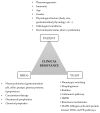Candida albicans Antifungal Resistance and Tolerance in Bloodstream Infections: The Triad Yeast-Host-Antifungal
- PMID: 31979032
- PMCID: PMC7074842
- DOI: 10.3390/microorganisms8020154
Candida albicans Antifungal Resistance and Tolerance in Bloodstream Infections: The Triad Yeast-Host-Antifungal
Abstract
Candida albicans represents the most frequent isolated yeast from bloodstream infections. Despite the remarkable progress in diagnostic and therapeutic approaches, these infections continue to be a critical challenge in intensive care units worldwide. The economic cost of bloodstream fungal infections and its associated mortality, especially in debilitated patients, remains unacceptably high. Candida albicans is a highly adaptable microorganism, being able to develop resistance following prolonged exposure to antifungals. Formation of biofilms, which diminish the accessibility of the antifungal, selection of spontaneous mutations that increase expression or decreased susceptibility of the target, altered chromosome abnormalities, overexpression of multidrug efflux pumps and the ability to escape host immune defenses are some of the factors that can contribute to antifungal tolerance and resistance. The knowledge of the antifungal resistance mechanisms can allow the design of alternative therapeutically options in order to modulate or revert the resistance. We have focused this review on the main factors that are involved in antifungal resistance and tolerance in patients with C. albicans bloodstream infections.
Keywords: C. albicans; Candida infections; antifungal resistance; bloodstream infections; virulence.
Conflict of interest statement
The authors declare no conflict of interests.
Figures
Similar articles
-
Candida and candidaemia. Susceptibility and epidemiology.Dan Med J. 2013 Nov;60(11):B4698. Dan Med J. 2013. PMID: 24192246 Review.
-
Development of Anti-Virulence Approaches for Candidiasis via a Novel Series of Small-Molecule Inhibitors of Candida albicans Filamentation.mBio. 2017 Dec 5;8(6):e01991-17. doi: 10.1128/mBio.01991-17. mBio. 2017. PMID: 29208749 Free PMC article.
-
In-vitro evaluation of virulence markers and antifungal resistance of clinical Candida albicans strains isolated from Karachi, Pakistan.Fungal Biol. 2023 Jul-Aug;127(7-8):1241-1249. doi: 10.1016/j.funbio.2023.04.003. Epub 2023 Apr 14. Fungal Biol. 2023. PMID: 37495314
-
Resistance in human pathogenic yeasts and filamentous fungi: prevalence, underlying molecular mechanisms and link to the use of antifungals in humans and the environment.Dan Med J. 2016 Oct;63(10):B5288. Dan Med J. 2016. PMID: 27697142 Review.
-
Small molecules restore azole activity against drug-tolerant and drug-resistant Candida isolates.mBio. 2023 Aug 31;14(4):e0047923. doi: 10.1128/mbio.00479-23. Epub 2023 Jun 16. mBio. 2023. PMID: 37326546 Free PMC article.
Cited by
-
A Preliminary Evaluation on the Antifungal Efficacy of VT-1161 against Persister Candida albicans Cells in Vulvovaginal Candidiasis.Biomedicines. 2024 Feb 7;12(2):389. doi: 10.3390/biomedicines12020389. Biomedicines. 2024. PMID: 38397991 Free PMC article.
-
Nystatin Encapsulated Nanoliposomes: Potential Anti-infective against Candida Spp. Isolated from Candidiasis Patients.Adv Biomed Res. 2024 Jul 29;13:56. doi: 10.4103/abr.abr_65_23. eCollection 2024. Adv Biomed Res. 2024. PMID: 39411705 Free PMC article.
-
Monoterpene antifungal activities: evaluating geraniol, citronellal, and linalool on Candida biofilm, host inflammatory responses, and structure-activity relationships.Front Pharmacol. 2024 Jul 19;15:1394053. doi: 10.3389/fphar.2024.1394053. eCollection 2024. Front Pharmacol. 2024. PMID: 39101130 Free PMC article.
-
In silico molecular modelling studies and antibiofilm efficacy of shikonin against Candida albicans: mechanistic insight.Arch Microbiol. 2023 Feb 17;205(3):93. doi: 10.1007/s00203-023-03426-x. Arch Microbiol. 2023. PMID: 36800037
-
Plausible Mechanistic Insights in Biofilm Eradication Potential against Candida spp. Using In Situ-Synthesized Tyrosol-Functionalized Chitosan Gold Nanoparticles as a Versatile Antifouling Coating on Implant Surfaces.ACS Omega. 2022 Mar 1;7(10):8350-8363. doi: 10.1021/acsomega.1c05822. eCollection 2022 Mar 15. ACS Omega. 2022. PMID: 35309435 Free PMC article.
References
-
- Calderone R., editor. Candida and Candidiasis. ASM Press; Washington, DC, USA: 2002.
-
- Segal B.H., Almyroudis N.G., Battiwalla M., Herbrecht R., Perfect J.R., Walsh T.J., Wingard J.R. Prevention and early treatment of invasive fungal infection in patients with cancer and neutropenia and in stem cell transplant recipients in the era of newer broad-spectrum antifungal agents and diagnostic adjuncts. Clin. Infect. Dis. Off. Publ. Infect. Dis. Soc. Am. 2007;44:402–409. doi: 10.1086/510677. - DOI - PubMed
Publication types
LinkOut - more resources
Full Text Sources


